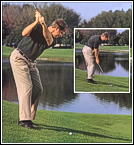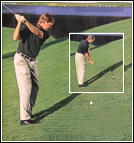
2005 PGA National Teacher of the Year
GOLF Magazine Top 100 Instructor
PGA Master Professional
GOLF Magazine Top 100 Instructor
PGA Master Professional
Take your Golf Game to the next level
GOLF TIPS

If your swing is too flat, the club approaches from too far inside.

If your swing is too upright, the club approaches from too far outside.

Bend from the waist to create a more upright swing. Club will return along the target line.

Bend less from the waist to create a flatter swing. Club will return along the target line.
PRACTICING FROM ANGLED LIES WILL GET YOUR SWING BACK ON TRACK
For most golfers, consistently making solid contact is more dream than reality. This doesn't mean, however, that it's an unattainable goal. Getting the club to move along the correct plane is the key to a successful swing. Ideally, you should swing the club on a plane that is consistent to the shaft's angle at address. Most golfers fight swings that are too flat or too vertical. When your swing is too flat (1st photo), the club usually approaches the ball from too far inside the target line (1st photo inset) resulting in a hook, push or topped shot. If you're not sure where your problems lie, get off that flat practice tee and head for the sloped sides of the range that-depending on your tendency-will provide a quick solution to refine your swing.
FLAT SWING, BALL BELOW FEET
If you're swing plane is too flat, practice with the ball below your feet (3rd photo). When the ball is below your feet, your spine angle becomes more tilted to address the ball, forcing your shoulders to turn on a more vertical plane during the backswing. Keep your balance equally on your feet-don't lean back into the slope. During the swing, concentrate on allowing your arms to stay more in front of your body throughout the swing. This should help you deliver the clubhead on a straighter path (3rd photo inset) and more solid contact should result. If the hooks and blocked shots to the right disappear, then you know that your path is correctly matched to the shaft angle at address.
UPRIGHT SWING, BALL ABOVE FEET
If your swing plane is too upright, hit balls well above your feet (4th photo). When the ball is above your feet, your spine angle will become more vertical, forcing your shoulders to swing on a flatter plane. Remember, the key to a flatter plane is to let your arms rotate. During the backswing, the left arm rotates over the right; in the downswing, the arms rotate back to their original position so the club approaches the ball from just inside the target line (4th photo inset). In the follow-through, the right forearm will rotate over the left. When you do this correctly, you'll make solid contact with the back of the ball from inside the target line and the result will be a longer-flying, right-to-left draw.
MONITOR YOUR SHOTS. Hit shots from the sides of the
practice tee until the ball flight matches the slope you are hitting from-a draw when the ball is above your feet and a fade with the ball below your feet. Once
you see this, go to a flat lie and see if your ball flight has changed. If not, hit 10 more shots from the appropriate slope and then 10 from a flat lie.
Keep doing this until you can match the ball flight from a flat lie with the flight from the sidehill lie. Many golfers tend to over-correct, so
always pay attention to the flight of the ball-it will tell you exactly what is going on in your swing.